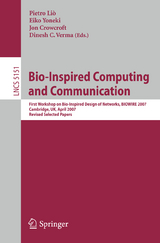Bio-Inspired Computing and Communication
Springer Berlin (Verlag)
978-3-540-92190-5 (ISBN)
Bio-Inspired Computing and Communication.- Biological Networks.- A Complex Network Approach to the Determination of Functional Groups in the Neural System of C. Elegans.- Modelling Gene Regulatory Networks.- The Role of Simplifying Models in Neuroscience: Modelling Structure and Function.- An Artificial Chemistry for Networking.- Biomimicry: Further Insights from Ant Colonies?.- Network-Related Challenges and Insights from Neuroscience.- Network Epidemics.- Networks in Epidemiology.- Epidemiology and Wireless Communication: Tight Analogy or Loose Metaphor?.- Epidemic Spreading of Computer Worms in Fixed Wireless Networks.- Wireless Epidemic Spread in Dynamic Human Networks.- Complex Networks.- Stochastic Spreading Processes on a Network Model Based on Regular Graphs.- Weighted and Directed Network on Traveling Patterns.- Communication Networks in Insect Societies.- The Topological Fortress of Termites.- Evolutionary and Temporal Dynamics of Transcriptional Regulatory Networks.- Phase Patterns of Coupled Oscillators with Application to Wireless Communication.- Self-organizing Desynchronization and TDMA on Wireless Sensor Networks.- Bio-Inspired Network Model.- Bio-Inspired Multi-agent Collaboration for Urban Monitoring Applications.- Bio-Inspired Approaches for Autonomic Pervasive Computing Systems.- Biologically Inspired Self Selective Routing with Preferred Path Selection.- Biologically Inspired Approaches to Networks: The Bio-Networking Architecture and the Molecular Communication.- Network Protocol in Wireless Communication.- User-Centric Mobility Models for Opportunistic Networking.- Wavelet-Domain Statistics of Packet Switching Networks Near Traffic Congestion.- A Circulatory System Approach for Wireless Sensor Networks.- Epcast: Controlled Dissemination inHuman-Based Wireless Networks Using Epidemic Spreading Models.- Maintaining Spatial-Temporal Knowledge through Human Interaction.- Data Management.- Beta Random Projection.- Biologically Inspired Classifier.- Distributed Computing.- Human Heuristics for Autonomous Agents.- Designing Biological Computers: Systemic Computation and Sensor Networks.- A Rule System for Network-Centric Operation in Massively Distributed Systems.- Field-Based Coordination for Pervasive Computing Applications.- Coalition Games and Resource Allocation in Ad-Hoc Networks.- Security.- Bio-Inspired Topology Maintenance Protocols for Secure Wireless Sensor Networks.- Dynamic Topologies for Robust Scale-Free Networks.
| Erscheint lt. Verlag | 18.12.2008 |
|---|---|
| Reihe/Serie | Lecture Notes in Computer Science | Theoretical Computer Science and General Issues |
| Zusatzinfo | X, 428 p. |
| Verlagsort | Berlin |
| Sprache | englisch |
| Maße | 155 x 235 mm |
| Gewicht | 668 g |
| Themenwelt | Informatik ► Theorie / Studium ► Algorithmen |
| Mathematik / Informatik ► Mathematik ► Wahrscheinlichkeit / Kombinatorik | |
| Schlagworte | Ad-Hoc Networks • Algorithm analysis and problem complexity • ant colony optimization • Bio-Inspired Networking • Bridge • Complex Adaptive Systems • complex networks • distributed algorithms • Distributed Computing • gene regulatory networks • Hardcover, Softcover / Informatik, EDV/Informatik • Load Balancing • microarray • mobile networks • Modeling • multi-agent coordination • multi-dimensi • multi-dimensional indexing • nano-scale biological networks • Natural Computation • network epidemics • network measurement • neural network • Neuroscience • Pervasive Computing • RFID • RFID (Radio Frequency Identificatio) • security • Self-Organization • sensor networks • Simulation • Social insects • Social Networks • spatial networks • stochastic models • Topology |
| ISBN-10 | 3-540-92190-7 / 3540921907 |
| ISBN-13 | 978-3-540-92190-5 / 9783540921905 |
| Zustand | Neuware |
| Haben Sie eine Frage zum Produkt? |
aus dem Bereich




